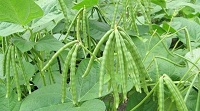Pharmacognostic and Phytochemical screening of Cowpea seeds (Vigna unguiculata)
Keywords:
Vigna unguiculata, Phytochemical screening, Pharmacognostic studies, Total phenol, Flavonoid contentAbstract
Vigna unguiculata (Cow pea) is well known medicinal plant. The drug isolated from this plant is used in different science of medicines like, ayurveda, unani, sidda, allopathic, homeopathic and naturopathic therapy. The present investigation deals with pharmacognostic and phytochemical screening of the seeds of Vigna uguiculata. The pharmacognostic studies include physicochemical constant and fluorescence analysis. The petroleum ether, chloroform, methanol and aqueous extracts are subjected to preliminary phytochemical screening. The physicochemical constants obtained were found to be within normal levels prescribed by phytochemical standards. The phytochemical studies of seeds of Vigna uguiculata revealed the presence of primary and secondary metabolites like proteins, carbohydrates, glycosides, phenols,flavonoids, saponins, sterols and alkaloids. The flavonoid content of methanol extract was found to be 621± 2.494 µg rutin/g. These studies provide a referential information for identification of this crude drug and the results are helpful for the isolation of medicinally important active components.
References
. Priya S, Santhiya S. Phytochemical
properties and antibacterial activity of
allotropic procera extracts against
human pathogens.Adv pharamacol
Toxicol 2011; 12(2):21-24.
. Gokhale SB. Textbook of
Pharmacognosy, Nirali Prakashan,
Pune,(1979).
. Mukherjee PK, Quality Control of
Herbal Drugs, an Approach to
evaluation of Botanicals, Business
Horizons Pharmaceutical Publishers,
New Delhi (2002), pp 186.
. Raghunathan K. Pharmacopoeial
standards for Ayurvedic formulations.
Central Council for Research in Indian
Medicine and Homoeopathy, New
Delhi, India ,(1976), pp. 42.
. Trease G.E, Evans WC.
Pharmacognosy, Harcourt brace & Co.
Asia, Pvt. Ltd., W.B. Saunders
Company Ltd., 15th edition, 2002.
. Kadam PV, Yadav KN, Narappanawar
NS, Shivatare RS, Bhusnar HU, Patil
MJ. Pharmacognosy Journal, 2011,
(26), 19-24.
. Summerfield RJ, Huxley PA, Stelle W.
Cowpea (Vigna unguiculata L. Walp).
Field Crop Abstr 1974; 27: 301ă312.
. Duke JA. Introduction to food legumes,
IN: S. R. Singh (Ed.). Insect pests of
tropical food legumes 1990; pp1ă42
(Chichester, United Kingdom: John
Wiley & Sons).
. Chopra RN, Nayar SL, Chopra IC.
Glossary of Indian medicinal plant 1986
(including the supplement), (New Delhi:
Council of Scientific and Industrial
Research).
. Van Wyk BE & Gericke N. People's
plants: A guide to useful plants of
Southern Africa 2000; pp. 192
(Pretoria, South Africa: Briza
Publications).
. Kritzinger Q, Lall N, Aveling TAS.
Antimicrobial activity of cowpea (Vigna
unguiculata) leaf extracts. South
African Journal of Botany 2005; 71:
ă48.
. Indian Pharmacopoeia,Government of
India, Ministry of Health and Family
Welfare,Controller of Publication, 4th
ed, New Delhi, 4(II);1996, A53-A54.
. WHO/PHARM/92.559/rev.1, Quality
Control Methods for Medicinal Plant
Materials .Chase C R and Pratt R S.,
Fluorescence of Powdered Vegetable
drugs with particular reference to
Development of a System of
Identification. J Am Pharmacol
Assoc1949 ; 38:32.
. Kokoshi CJ, Kokoshi RJ and Sharma
FT. Fluorescence of powdered
vegetablerugs under Ultraviolet
radiation. J Pharm Asses 1958;
:715-717.
. Kokate CK, Khandelwal KR, Pawar AP,
Gokhale SB. Practical
Pharmacognosy,Nirali Prakashan 1995
; 1:11-19.
. Harborne JB. Methods of extraction
and isolation In: Phytochemical
methods, 3rd Ed., Chapman and Hall,
London1998; 60-66.
. Raghuramulu N, Madhava Nair K,
Kalyanasundaram S. A manual of
Laboratory techniques: National
Institute of Nutrition, Hydrabad 2003; p:
-195.
. Alfawaz MA. Chemical composition of
hummayd (Rumex vesicarius) grown in
Saudi Arabia. Journal of food
composition and analysis 2006;
:552-555.
. Filho JMB, Alencar AA, Nunes XP,
Tomaz AC, Filho SJG, Petronio FA,
Silva MS, Souza MFV, and Cunha
EVL. (2008). Source of alpha-, beta-,
gamma-, delta-, and epsiloncarotenes: A twententieth century
review. Brazillian Journal of
Pharmacognosy, 18(1) 135-134.
. African Pharmacopoeia. General
methods for analysis Is ted. 2:
(OAU/STRC) Logos. 1986; p.123.
. Musa KY, Katsayal AU, Ahmed A,
Mohammed Z, Danmalam UH.
Pharmacognostic investigation of the
leaves of Gisekia pharmacioides.
African J. Biotech. 2006; 956-957.
. Kadam PV, Yadav KN, Deoda RS,
Narrappanawar NS, Shivtare RS, Patil
MJ. Pharmacognostic and
Phytochemical Studies on Roots of
Agave Americana (Agavaceae).
International Journal of
Pharmacognosy & phytochemical
Reasearch 2012;4(3):92-96.
. Pimenta AM, Montenegro MC, Araujo
AN, Martinez JC. 2006. Application of
sequential injections analysis to
pharmaceutical analysis. J Pharmaceut
Biomed 40: 16-34.
. Mohan Kalaskar G, Sanjay Surana
J.Pharmacognostic and phytochemical
studies on Ficus Microcarpa L.fil. Anc
Sci Life 2012; oct-dec 32(2): 107-111.
. Jimoh FO, Adedapo AA, Aliero AA and
Afolayan A. (2008). Polyphenolic
contents and biological activities
of Rumex ecklonianus. Pharm. Biol.,
: 333-340.



